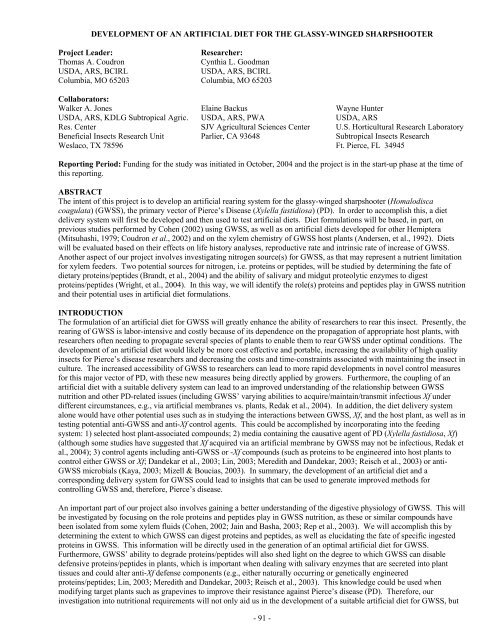Impact Of Host Plant Xylem Fluid On Xylella Fastidiosa Multiplication ...
Impact Of Host Plant Xylem Fluid On Xylella Fastidiosa Multiplication ...
Impact Of Host Plant Xylem Fluid On Xylella Fastidiosa Multiplication ...
Create successful ePaper yourself
Turn your PDF publications into a flip-book with our unique Google optimized e-Paper software.
DEVELOPMENT OF AN ARTIFICIAL DIET FOR THE GLASSY-WINGED SHARPSHOOTER<br />
Project Leader:<br />
Thomas A. Coudron<br />
USDA, ARS, BCIRL<br />
Columbia, MO 65203<br />
Collaborators:<br />
Walker A. Jones<br />
USDA, ARS, KDLG Subtropical Agric.<br />
Res. Center<br />
Beneficial Insects Research Unit<br />
Weslaco, TX 78596<br />
Researcher:<br />
Cynthia L. Goodman<br />
USDA, ARS, BCIRL<br />
Columbia, MO 65203<br />
Elaine Backus<br />
USDA, ARS, PWA<br />
SJV Agricultural Sciences Center<br />
Parlier, CA 93648<br />
Wayne Hunter<br />
USDA, ARS<br />
U.S. Horticultural Research Laboratory<br />
Subtropical Insects Research<br />
Ft. Pierce, FL 34945<br />
Reporting Period: Funding for the study was initiated in October, 2004 and the project is in the start-up phase at the time of<br />
this reporting.<br />
ABSTRACT<br />
The intent of this project is to develop an artificial rearing system for the glassy-winged sharpshooter (Homalodisca<br />
coagulata) (GWSS), the primary vector of Pierce’s Disease (<strong>Xylella</strong> fastidiosa) (PD). In order to accomplish this, a diet<br />
delivery system will first be developed and then used to test artificial diets. Diet formulations will be based, in part, on<br />
previous studies performed by Cohen (2002) using GWSS, as well as on artificial diets developed for other Hemiptera<br />
(Mitsuhashi, 1979; Coudron et al., 2002) and on the xylem chemistry of GWSS host plants (Andersen, et al., 1992). Diets<br />
will be evaluated based on their effects on life history analyses, reproductive rate and intrinsic rate of increase of GWSS.<br />
Another aspect of our project involves investigating nitrogen source(s) for GWSS, as that may represent a nutrient limitation<br />
for xylem feeders. Two potential sources for nitrogen, i.e. proteins or peptides, will be studied by determining the fate of<br />
dietary proteins/peptides (Brandt, et al., 2004) and the ability of salivary and midgut proteolytic enzymes to digest<br />
proteins/peptides (Wright, et al., 2004). In this way, we will identify the role(s) proteins and peptides play in GWSS nutrition<br />
and their potential uses in artificial diet formulations.<br />
INTRODUCTION<br />
The formulation of an artificial diet for GWSS will greatly enhance the ability of researchers to rear this insect. Presently, the<br />
rearing of GWSS is labor-intensive and costly because of its dependence on the propagation of appropriate host plants, with<br />
researchers often needing to propagate several species of plants to enable them to rear GWSS under optimal conditions. The<br />
development of an artificial diet would likely be more cost effective and portable, increasing the availability of high quality<br />
insects for Pierce’s disease researchers and decreasing the costs and time-constraints associated with maintaining the insect in<br />
culture. The increased accessibility of GWSS to researchers can lead to more rapid developments in novel control measures<br />
for this major vector of PD, with these new measures being directly applied by growers. Furthermore, the coupling of an<br />
artificial diet with a suitable delivery system can lead to an improved understanding of the relationship between GWSS<br />
nutrition and other PD-related issues (including GWSS’ varying abilities to acquire/maintain/transmit infectious Xf under<br />
different circumstances, e.g., via artificial membranes vs. plants, Redak et al., 2004). In addition, the diet delivery system<br />
alone would have other potential uses such as in studying the interactions between GWSS, Xf, and the host plant, as well as in<br />
testing potential anti-GWSS and anti-Xf control agents. This could be accomplished by incorporating into the feeding<br />
system: 1) selected host plant-associated compounds; 2) media containing the causative agent of PD (<strong>Xylella</strong> fastidiosa, Xf)<br />
(although some studies have suggested that Xf acquired via an artificial membrane by GWSS may not be infectious, Redak et<br />
al., 2004); 3) control agents including anti-GWSS or -Xf compounds (such as proteins to be engineered into host plants to<br />
control either GWSS or Xf; Dandekar et al., 2003; Lin, 2003; Meredith and Dandekar, 2003; Reisch et al., 2003) or anti-<br />
GWSS microbials (Kaya, 2003; Mizell & Boucias, 2003). In summary, the development of an artificial diet and a<br />
corresponding delivery system for GWSS could lead to insights that can be used to generate improved methods for<br />
controlling GWSS and, therefore, Pierce’s disease.<br />
An important part of our project also involves gaining a better understanding of the digestive physiology of GWSS. This will<br />
be investigated by focusing on the role proteins and peptides play in GWSS nutrition, as these or similar compounds have<br />
been isolated from some xylem fluids (Cohen, 2002; Jain and Basha, 2003; Rep et al., 2003). We will accomplish this by<br />
determining the extent to which GWSS can digest proteins and peptides, as well as elucidating the fate of specific ingested<br />
proteins in GWSS. This information will be directly used in the generation of an optimal artificial diet for GWSS.<br />
Furthermore, GWSS’ ability to degrade proteins/peptides will also shed light on the degree to which GWSS can disable<br />
defensive proteins/peptides in plants, which is important when dealing with salivary enzymes that are secreted into plant<br />
tissues and could alter anti-Xf defense components (e.g., either naturally occurring or genetically engineered<br />
proteins/peptides; Lin, 2003; Meredith and Dandekar, 2003; Reisch et al., 2003). This knowledge could be used when<br />
modifying target plants such as grapevines to improve their resistance against Pierce’s disease (PD). Therefore, our<br />
investigation into nutritional requirements will not only aid us in the development of a suitable artificial diet for GWSS, but<br />
- 91 -











